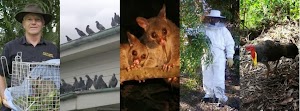The short answer is no. There are a number of manufacturers of devices that claim to repel various animals and there is a scientific basis for the claims, but is that effect of practical use?
The writer has personally seen a mouse sitting on top of a device sold to repel rodents and Peter the Possum Man has had many customers over the years who have tried to get rid of birds, microbats, rats and possums with these style of devices. They are not cheap!
If any animal knows a certain area is a safe place to sleep or a good source of food, it is very unlikely that ultrasonic devices will deter it. Perhaps if there are two houses with gaps in the roof and a possum checks them both out, it will choose the one without a deterrent, but if one house already has the odour trail of that possum, then the animal will have a very strong incentive to avoid the risk of going to an unknown location. While there are cases where newly installed deterrent noises, flashing lights and ultrasonic sounds have all successfully evicted birds and possums initially, it’s the writer’s firm experience that the effect does not last for long.
Peter the Possum & Bird Man has had contact with several researchers from the University of Queensland who have looked at studies on this type of equipment; preliminary testing has shown erratic results and the researchers have quickly lost interest in pursuing what for them seems to be a “dead end”, so little Queensland research on this subject has actually been completed.
However a recent study from UQ by Bradley Gale, Andrew Tribe and Luke Leung (in press 2014), concluded that the ultrasonic devices they tested “did not repel brushtail possums from feeding on a highly palatable food” and that the devices tested were not effective for repelling possums “from consuming food in suburban gardens”. They did record some minor effects and it is possible to demonstrate that possums do react to the presence of these devices.
This UQ study agrees with other published work, in particular a 1994 study by Coleman and Tyson that was supported by Government Landcare Research in New Zealand where feral possums are causing major problems. It is logical that if there was an effective way to use the devices for possums, then the New Zealanders would have researched enough options to find it, as they have a major incentive to reduce the serious impact the introduced possums are having on their own native wildlife.
The ultrasonic frequency is selected because it is outside the range of normal human hearing, but due to its intensity, for those animals that can hear it, the noise is predicted to cause pain, disorientation and fear, possibly also interrupting communication between those animals. However a wide range of other published work referred to by Gale et. al., has shown little or no repellent effect on wallabies, mosquitos, cockroaches, badgers, kangaroos, dingoes, deer, birds, bats and even cats. Hidden cameras used in field studies will show the animals responding by lifting their head, looking about and then continuing to eat.
Given the wealth of published research on such a wide range of animals it is truly amazing that the manufacturers continue to make extravagant claims for the repellent effects of ultrasonic devices.







